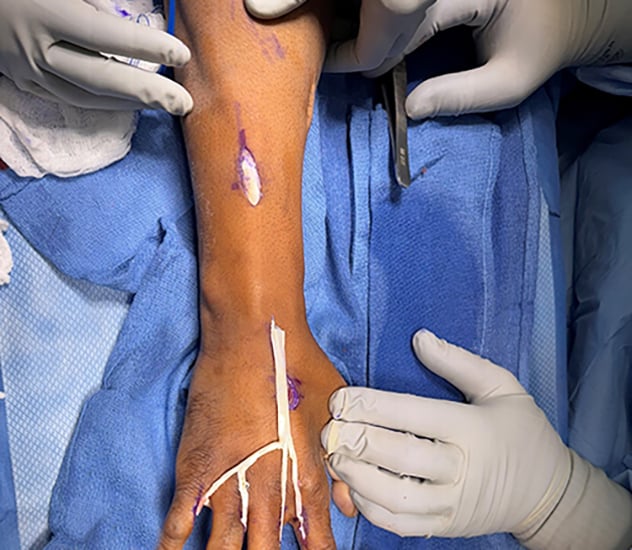March 29, 2025
While most orthopedic surgeons don't prefer to see a nerve during surgery — due to the potential for damage — a hand surgeon will seek out and find the nerve, according to Courtney R. Carlson Strother, M.D., an orthopedic surgeon specializing in hand and upper extremity surgery at Mayo Clinic's campus in Minnesota.
"It's optimal to be able to refer to a surgeon who likes doing nerve surgery," she says.
Trauma can compress, crush, cut or stretch peripheral nerves. Mechanisms of injury for peripheral nerve injury, she says, include:
- Motor vehicle crashes.
- Machinery crush incidents and traumatic cuts to the arm and hand.
- Postsurgical complications or unintentional damage during other surgeries.
Patients typically experience pain, tingling, numbness and loss of function with a peripheral nerve injury. Symptoms reflect the type of nerve affected. Dr. Carlson Strother says that the severity of nerve injuries can range from mild to severe, and the severity can be challenging to diagnose early on.
"When patients get their hands or arms cut or crushed, it's challenging to know if the nerve will recover on its own or not," she says. "These types of injuries require multiple examinations over time to understand what, if any, nerve function will recover."
For best outcomes, she recommends that patients see a peripheral nerve injury specialist within 1 to 2 months of the injury and that healthcare professionals place referrals as soon as they suspect nerve injury. When Dr. Carlson Strother sees patients she suspects may have a peripheral nerve injury, she talks with them about their medical histories and the nature of their injuries and conducts a physical exam. Ultrasound, MRI and nerve conduction studies are often used to supplement the clinical evaluation.
Dr. Carlson Strother notes that typically, a physiatrist will perform a nerve conduction study and EMG to assess the health of the injured nerve. This study is performed by using surface electrodes applied to the skin over the course of the injured nerve to determine whether it demonstrates complete function.
Surgical referral and outcomes
Physicians may refer patients for peripheral nerve surgery evaluation from external medical centers or internally within Mayo Clinic. Dr. Carlson Strother indicates that the need for this referral is typically clear due to a patient's loss of function in the upper extremity and neuropathic pain.
Management of these injuries may be surgical or nonsurgical. Dr. Carlson Strother says that occasionally, serial testing of a patient's nerve injury indicates that the damage will likely recover by itself and surgery is unnecessary. She also states that surgical repair of an upper extremity peripheral nerve injury rarely returns patients to 100% of preinjury status. However, she says that the hope is to help patients regain some hand, shoulder or elbow function following surgery.
 Four-tailed ulnar nerve tendon transfer
Four-tailed ulnar nerve tendon transfer
Dr. Carlson Strother and team prepare to perform a four-tail ulnar nerve tendon transfer.
Surgery may involve nerve repair only. If the injury severed a patient's nerve, Dr. Carlson Strother and colleagues can put it back together, grafting across the injured area. Some nerve injuries require transfer to the injured upper extremity from locations in the patient's body where the absence will not affect function. For example, the wrist contains three muscles involved in bending, but this action is uncompromised if the surgeon removes only one muscle from this region for transfer. For a nerve transfer, the surgeon evaluates the nerve before making a cut to ensure it is not critical to the function it is currently performing. Peripheral nerve surgery may last from a couple of hours to as long as eight hours depending on what the injury requires.
To set a patient's surgical expectations, Dr. Carlson Strother and team provide education on these factors:
- Peripheral nerve status. Patients need a detailed, lay-level explanation of what is transpiring in their upper extremities and the necessary surgical repairs.
- Potential surgical gains. Although a repair that would restore a patient's preinjury status is unlikely, most patients can make some gains postsurgically.
- Nerve growth rate. Nerves are slow growing and may require up to one year to improve.
While most patients do qualify for some level of surgical repair for peripheral nerve injury, significant medical comorbidities can make them ineligible.
Postsurgically, Dr. Carlson Strother emphasizes the importance of physical therapy to avoid contractures or the inability to move a joint.
She also notes that peripheral nerve repair surgery is well covered by insurance.
Why refer to Mayo Clinic
While upper extremity peripheral nerve surgery has become popular among hand surgeons, Dr. Carlson Strother suggests referring patients to Mayo Clinic for this procedure. She notes that Mayo Clinic has a robust team of hand surgeons who work together frequently on these surgeries and enjoy making these repairs. The hand surgery team also works closely with Mayo Clinic physiatrists and radiologists on high-quality nerve studies and ultrasounds. The team has optimized its processes to allow patients to be seen promptly.
Dr. Carlson Strother says she requests that referring physicians send her a patient's relevant operative notes and testing results.
She also says that if she and colleagues determine a patient's medical needs include more than treatment of the peripheral nerve injury, they can connect with a Mayo Clinic physician anywhere in the institution who can address that issue.
For more information
Refer a patient to Mayo Clinic.